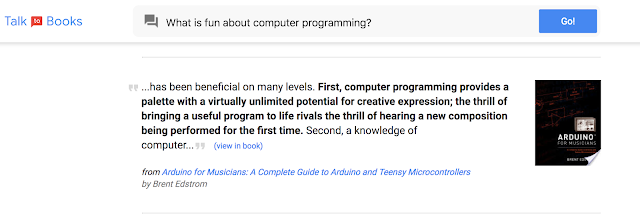Introducing Semantic Experiences with Talk to Books and Semantris
Source: Introducing Semantic Experiences with Talk to Books and Semantris from Google Research
Posted by Ray Kurzweil, Director of Engineering and Rachel Bernstein, Product Manager, Google Research
Natural language understanding has evolved substantially in the past few years, in part due to the development of word vectors that enable algorithms to learn about the relationships between words, based on examples of actual language usage. These vector models map semantically similar phrases to nearby points based on equivalence, similarity or relatedness of ideas and language. Last year, we used hierarchical vector models of language to make improvements to Smart Reply for Gmail . More recently, we’ve been exploring other applications of these methods.
Today, we are proud to share Semantic Experiences , a website showing two examples of how these new capabilities can drive applications that weren’t possible before. Talk to Books is an entirely new way to explore books by starting at the sentence level, rather than the author or topic level. Semantris is a word association game powered by machine learning, where you type out words associated with a given prompt. We have also published “ Universal Sentence Encoder ”, which describes the models used for these examples in more detail. Lastly, we’ve provided a pretrained semantic TensorFlow module for the community to experiment with their own sentence and phrase encoding.
Modeling approach
Our approach extends the idea of representing language in a vector space by creating vectors for larger chunks of language such as full sentences and small paragraphs. Since language is composed of hierarchies of concepts, we create the vectors using a hierarchy of modules, each of which considers features that correspond to sequences at different temporal scales. Relatedness, synonymy, antonymy, meronymy, holonymy, and many other types of relationships may all be represented in vector space language models if we train them in the right way and then pose the right “questions”. We describe this method in our paper, “ Efficient Natural Language Response for Smart Reply .”
Talk to Books
With Talk to Books , we provide an entirely new way to explore books. You make a statement or ask a question, and the tool finds sentences in books that respond, with no dependence on keyword matching. In a sense you are talking to the books, getting responses which can help you determine if you’re interested in reading them or not.
 |
| Talk to Books |
The models driving this experience were trained on a billion conversation-like pairs of sentences, learning to identify what a good response might look like. Once you ask your question (or make a statement), the tools searches all the sentences in over 100,000 books to find the ones that respond to your input based on semantic meaning at the sentence level; there are no predefined rules bounding the relationship between what you put in and the results you get.
This capability is unique and can help you find interesting books that a keyword search might not surface, but there’s still room for improvement. For example, this experiment works at the sentence level (rather than at the paragraph level, as in Smart Reply for Gmail) so a “good” matching sentence can still be taken out of context. You might find books and passages that you didn’t expect, or the reason a particular passage was highlighted might not be obvious. You may also notice that being well-known does not make a book sort to the top; this experiment looks only at how well the individual sentences match up. However, one benefit of this is that the tool may help people discover unexpected authors and titles, and surface books in a way that is fresh and innovative.
Semantris
We are also providing Semantris , a word association game that is powered by this technology. When you enter a word or phrase, the game ranks all of the words on-screen, scoring them based on how well they respond to what you typed. Again, similarity, opposites and neighboring concepts are all fair-game using this semantic model. Try it out yourself to see what we mean! The time pressure in the Arcade version (shown below) will tempt you to enter in single words as prompts. The Blocks version has no time pressure, which makes it a great place to try out entering in phrases and sentences. You may enjoy exploring how obscure you can be with your hints.
 |
| Semantris Arcade |
The examples we’re sharing today are just a few of the possible ways to think about experience and application design using these new tools. Other potential applications include classification, semantic similarity, semantic clustering, whitelist applications (selecting the right response from many alternatives), and semantic search (of which Talk to Books is an example). We hope you’ll come up with many more, inspired by these example applications. We look forward to seeing original and innovative uses of our TensorFlow models by the developer community.
Acknowledgements
Talk to Books was developed by Aaron Phillips, Amin Ahmad, Rachel Bernstein, Aaron Cohen, Noah Constant, Ray Kurzweil, Igor Krivokon, Vladimir Magay, Peter McKenzie, Bryan Richter, Chris Tar, and Dave Uthus. Semantris was developed by Ben Pietrzak, RJ Mical, Steve Pucci, Maria Voitovich, Mo Adeleye, Diana Huang, Catherine McCurry, Tomomi Sohn, and Connor Moore. We’d also like to acknowledge Hallie Benjamin, Eric Breck, Mario Guajardo-Céspedes, Yoni Halpern, Margaret Mitchell, Ben Packer, Andrew Smart and Lucy Vasserman.
除非特别声明,此文章内容采用 知识共享署名 3.0 许可,代码示例采用 Apache 2.0 许可。更多细节请查看我们的 服务条款 。











![[HBLOG]公众号](https://www.liuhaihua.cn/img/qrcode_gzh.jpg)

